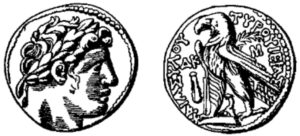Paper 172 Paper 174
Foundation Map: April 3 to April 5, 30 A.D.
Introduction
Section 1: Cleansing the Temple
p2,4,5: common people See subtopic: “Were the Alpheus twins subnormal?” For the larger context into which this study falls, see the Topical Study: Genetic Introductions, Mutations, and Evolution: a Urantia Book perspective.
p3: Jews coined their own silver money: The “Jewish money” proper, coined during the years of Hasmonean dynasty (164 – 35 B.C.) should not be confused with the Tyrian type half-shekels required for the Temple tax and other offerings (cf. Mishna Bek.8.7) and probably minted in Jerusalem after the mint in Tyre was closed down by Rome in 19 B.C. The Hasmonean money (so far only bronze coins have been found) never contained images of gods or people or animals, like the Tyrian silver shekels and half-shekels (see the picture).
 Jerusalem half-shekel of Tyrian type, 45 A.D. On the obverse we see Melkhart, god of the Phoenicians, corresponding to the Greek Hercules. The reverse shows the eagle and the letters “KP”. The meaning of “KP” is unknown, but this abbreviation is only present in the coins minted outside Tyre.
Jerusalem half-shekel of Tyrian type, 45 A.D. On the obverse we see Melkhart, god of the Phoenicians, corresponding to the Greek Hercules. The reverse shows the eagle and the letters “KP”. The meaning of “KP” is unknown, but this abbreviation is only present in the coins minted outside Tyre.
Section 2: Challenging the Master’s Authority
p8: insincerity is used six times: (9:5.7), (48:5.8), (82:1.10), (139:1.10), (173:2.8), (186:2.8).
insincere is used one time and about Lucifer: 53:2.5.
Section 3: Parable of the Two Sons
p2: common people See subtopic: “Were the Alpheus twins subnormal?” For the larger context into which this study falls, see the Topical Study: Genetic Introductions, Mutations, and Evolution: a Urantia Book perspective.
Section 4: Parable of the Absent Landlord
p2: shamefully See cross-reference study: Shame(ful(ly)) Lax.
Section 5: Parable of the Marriage Feast
p2: shamefully See cross-reference study: Shame(ful(ly)) Lax.
p4: sign(s) See Topical Study: Sign(s). Note: signs of the times appears twice. In both instances, the phase is part of a quote attributed to Jesus: See also, Topical Study: Prophecy and “signs of the times.”
Additional notes:
Matthew Block suggests that the following authors were influential in writing of this Paper and has prepared a parallel chart:
George A. Barton, Ph.D., LL.D., Jesus of Nazareth: A Biography (New York: The Macmillan Company, 1922) Hathi Trust Digital Library copy. Wikipedia page: Barton.
Rev. Alfred Edersheim, M.A.Oxon, D.D., Ph.D., The Life and Times of Jesus the Messiah (Volume One) (New York: Longman, Green, & Co., Eighth Edition, Revised, 1899) Hathi Trust Digital Library copy, V.1.Wikipedia page: Edersheim.
Rev. Alfred Edersheim, M.A.Oxon, D.D., Ph.D., The Life and Times of Jesus the Messiah (Volume Two) (New York: Longman, Green, & Co., Eighth Edition, Revised, 1899) Hathi Trust Digital Library copy, V.2.
Daniel A. Poling, Between Two Worlds: The Romance of Jesus (New York: Harper & Brothers Publishers, 1931) Wikipedia page: Poling.
Walter Russell Bowie, The Master: A Life of Jesus Christ (New York: Charles Scribner’s Sons, 1928) Wikipedia page: Bowie.
Wm. Arnold Stevens and Ernest Dewitt Burton, A Harmony of the Gospels for Historical Study: An Analytical Synopsis of the Four Gospels (New York: Charles Scribner’s Sons, 1904, 1932) Archive.org copy.
David Smith, M.A., D.D., Our Lord’s Earthly Life (New York: George H. Doran Company, 1925)
David Smith, M.A., D.D., The Days of His Flesh: The Earthly Life of Our Lord and Saviour Jesus Christ, Eighth Edition, Revised (New York: Harper & Brothers, 1910)
J. Middleton Murry, Jesus—Man of Genius (New York: Harper & Brothers Publishers, 1926) Wikipedia page: Murry.